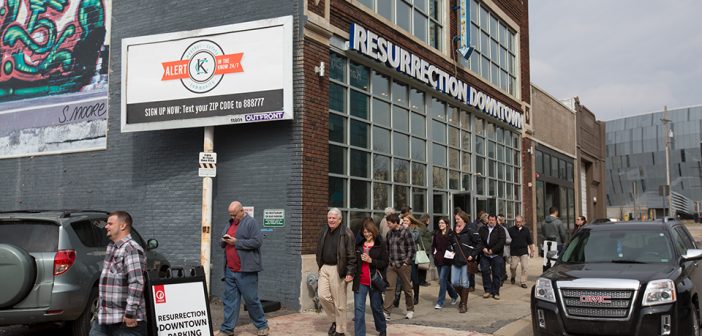Scott Crostek, pastor of Resurrection Downtown in Kansas City, says environments that are safe and welcoming for emerging generations are characterized not only by hospitality and authenticity, but also creativity, openness to holy mystery, and a sense of personal privacy.
Irresistible leadership environments are spaces with an atmosphere that facilitates effective emotional, relational, spiritual, and theological connections with God and with one another. Leadership environments that are irresistible to emerging generations tend to possess five primary facets.
1. Hospitality
Emerging generations seek out environments where they are noticed, welcomed, and made to feel at home. This looks like having multiple encounters where people can say, “Hello!”, offer their “Good Mornings!”, and remind others multiple times throughout the hour, “We’re so glad you’re here.” Being made to feel welcome and included is imperative because when you are made to feel at home, you will be more likely to be open and available to have an experience of God.
Many Millennials want to be welcomed and made to feel at home and, then, to be able to hide, to be anonymous and free to go at their own pace, or to sink into the rhythm and practices of the church.
2. Anonymity
In their haste to be welcoming, churches and their leaders sometimes compromise their ability to be hospitable. Hoping to secure participation and involvement from younger people, they end up singling out an entire segment of the population. Young adults leave feeling as though the church doesn’t want them there in the hope that they could meet God; they feel, instead, that the church actually wants them there to help grow the church. This is self-serving, alienating, and isolating, rather than hospitable. It forces young people into a place where they feel as though they are standing out in a crowd, even more than they already are.
Many Millennials want to be welcomed and made to feel at home and, then, to be able to hide, to be anonymous and free to go at their own pace, or to sink into the rhythm and practices of the church. A key to facilitating anonymity is preserving a sense of personal privacy within the worshipping congregation.
3. Authenticity
If we long to invite people to come as they are, then we must be willing to do the same. We must be willing to come to worship just as we are. This is authenticity. This is what draws emerging generations closer to God because it allows them to feel safe being open in the same way. So, make mistakes, don’t script transitions, and live into every invitation you extend to the congregation. If you invite people to pray silently, then you better do the same thing. If you challenge people in sermons with action steps, then you better take them, too. If you invite people to experience God’s presence in communion, then you must also treat communion as a worship experience in your own life, not just as something to provide or make possible as a leader. And in the moments you fail, share your experience of falling short.
Authenticity requires an ongoing admission of shortcomings and an unwavering openness to learning and growing from every person and situation you encounter. Humble leaders and authentic leaders are not dominating, polished, or perfected personalities. They are catalysts for authentic environments.
4. Mystery
While acknowledging the importance of authentic leadership in creating an irresistible environment for emerging generations, we must also acknowledge our need for something much greater than ourselves. We must create space in our churches for the God of the universe, the Holy Mystery we cannot fully comprehend, understand, or even imagine. Within the church, we describe sacraments as the primary pathways for us to experience the power of God’s promises. We can experience the life-saving power of God through baptism and Holy Communion.
5. Creativity
Resurrection Downtown’s vision is to transform the heart of the city authentically, passionately, and, perhaps most importantly, creatively. We wanted to be known for doing the same things that Christ did; we wanted to become co-creators. As this vision took shape and we began to grow, more and more artists and musicians began gravitating toward our emerging community and we tried to find ways to invite and incorporate their creativity.
We took the exterior wall of our church building and transformed it into a blank canvas for the community. We invited the most creative people in KC (and within our congregation) to display what Resurrection Downtown looked like to them. We also opened up our sanctuary walls in the hope that they might become gallery walls or what we imagined as modern day stained glass, inspired by local artists. Our worship services have become a place where people from the community introduce some of the most amazing fabric, oil, print, and photography. Over the past several years, we have found ourselves in a worship space that is clearly open to the everyday creativity, dreams, and wonder about how God is calling us to become the best versions of the people we were created to be.
This material is adapted from Scott Crostek’s book The Kaleidoscope Effect: What Emerging Generations Seek in Leaders (Abingdon Press, 2017). Used by permission. The book is available at Cokesbury and Amazon.
Related Resources
- Lessons from Churches that Reach Young Adults by Lovett H. Weems, Jr.
- Think Bigger: The Challenge of Reaching Millennials by David McAllister-Wilson
- Millennials Seek Larger Framework to Understand God by Chris Folmsbee







